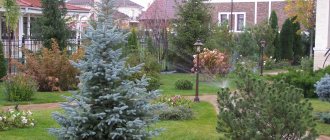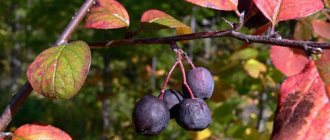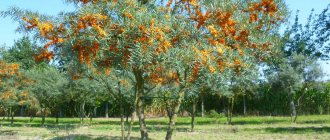Description of the plant
Indoor lemons are low-growing evergreen trees. Their homeland is Southeast Asia. Lemons look very impressive even without flowers and fruits.
Their beauty is enhanced by their shiny, leathery leaves. They contain essential oils. The leaf lifespan is about 2 years. The development of buds takes a little over a month. The flower lives for the same amount of time, filling the room with a delicate aroma.
Lemon at home (photo)
The fruits can take longer than 10 months to ripen. They contain juicy but sour pulp, consisting of segments. The seeds of this fruit have a dense parchment shell.
So, lemon is a beautiful indoor plant. Therefore, with its help you can make the room more attractive.
In addition, the pleasant smell of this fruit will always be present in the room during lemon blossom.
Growing lemon at home
Before moving on to the question of the conditions for lemon flowering, you should at least briefly become familiar with the methods of growing it. There are 2 of them: from a seed or from a cutting.
- When using the first method, you should take several of the largest seeds from a freshly cut lemon.
- When choosing the cutting method, one-year-old planting material is needed. You can borrow it from friends or buy it.
- The stalk should be about 10 cm long with 3 leaves.
Regardless of the chosen method, there are general planting rules:
- It should be carried out in April – June.
- The future plant needs a container no more than 10 cm in diameter.
- You need a hole at the bottom to drain excess moisture.
- Before planting a lemon, it is necessary to make drainage from small pebbles or expanded clay.
What does a lemon look like - photo
For growing from seeds, regular soil or special soil for citrus fruits is suitable.
When planting a plant using cuttings, it is better to put a 1 cm thick layer of moss on the drainage. Then fertile soil, leaving about 4 cm to the top of the pot. Then a layer of sand.
When planting, the seed should be deepened by 1 cm. Before performing this procedure, it is better to place the seedling for ½ day in a root former solution.
The future plant needs to choose a warm place. Otherwise, the pot with the seed planted in it should be covered with film.
To root a seedling, place an inverted jar on the container with it.
During this period, the plant needs regular moisture, warmth and light.
Usually the seeds germinate within a month or a little later. It will take a little longer for the seedling to take root. So, even an inexperienced gardener can grow lemons at home.
What is lemon 088
In nature, an evergreen tree can live up to almost 90 years. People have cultivated the plant for a very long time, and now lemons are grown almost everywhere as a valuable crop. Grows well in warm and mild climates.
In the north, lemons have adapted to be grown in greenhouse conditions, where they grow well with sufficient care. Many citrus lovers grow it at home. The variety was bred in Russia taking into account climatic conditions and cultivation in low light conditions.

It’s interesting to read: what is a Genoa lemon and find out how to buy lemon seedlings and how to choose them correctly.
Plant care
To achieve flowering of this plant at home, it is necessary, first of all, to take proper care of it. The secrets to good lemon care are as follows:
- It should not be moved from one place to another. The plant should develop evenly. To do this, the tree needs to be turned slightly every 10 days so that the pot rotates completely within a year.
- Lemon cares about space. 2 m is the minimum distance from the floor to the stand.
- 14-27 °C is the optimal temperature for the comfortable existence of the plant.
- It needs to be provided with good humidity (about 70%). Therefore, you should not place the tree near the heating system. You need to spray it often.
- An east-facing window is an ideal place for this plant, as it benefits from morning sun in summer. In winter, lemon needs about 5 hours of illumination.
- Water the tree with settled water. This should be done 2 times a day, in the morning and evening. There must be a water tray under the pot.
- Plants require regular replanting. It is better to do it in early spring.
- This procedure is carried out, for example, if the pot size is insufficient. It is needed if the leaves turn yellow, the soil has become sour, etc.
- When pests appear, you must immediately begin to fight them.
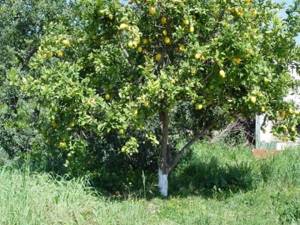
Lemon tree begins to bear fruit (photo)
Thus, caring for lemon is quite simple. The main thing is to carry it out with soul.
Priming
You can use ready-made soil from the store or prepare the mixture yourself. In preparation, equal parts of humus, deciduous and turf soil are used. River sand and pieces of coal are added to the mixture.

To prevent waterlogging, drainage made from pieces of brick and expanded clay is used.
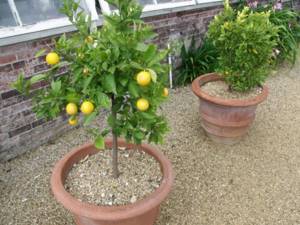
Lemon needs feeding frequently. In the summer season - once a week. The rest - at least once a month.
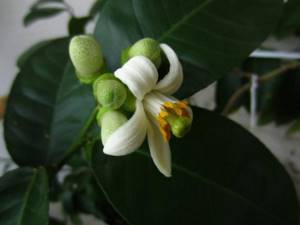
Lemon blossoms at home
Under no circumstances should a lemon be allowed to bloom during its first year. Since this will deplete the tree so much that it may lead to its death. Even if it miraculously survives, it is unlikely to be able to produce a good harvest.
How to get a plant to bloom? Of course, this can be achieved if you follow a number of important rules:
In winter, the tree should be placed in the coolest corner of the room to ensure complete rest. This event will help avoid the appearance of a meager number of buds.
It is necessary to combat excessive flowering, which can significantly weaken the health of the plant. Therefore, it is necessary to pick off its buds until the number of leaves on the tree is at least 20. It is believed that 10 adult leaves can feed 1 fruit.
How lemon blooms at home - photo
Therefore, the number of ovaries left should depend on their number. Lemon blooms best in a cool room.
If it is grown from a seed, then correctly done grafting will help to significantly speed up the onset of flowering. It comes in two types: budding (inserting a bud with a thin woody layer into the bark of a tree) and grafting with a cutting (a twig with several leaves is used).
In addition, the tree should be fed and pruned. The features of these events will be revealed in the next part of the article.
Knowing the secrets of growing lemon will help its owner to ensure the plant blooms and enjoy a decent harvest.
Expert opinion
Yulia Yurievna
I have a large garden and vegetable garden, several greenhouses. I love modern methods of cultivating plants and mulching the soil, and I share my experience.
Ask a Question
Why lemons don't bloom at home
How long does a lemon grow before it starts to bloom and bear fruit? When grown from cuttings, this occurs already in the second year of the plant’s life, if the planting was carried out correctly and the care was correct. But sometimes this doesn't happen. We need to figure out why the lemon doesn’t bloom. The most common reason is improper care. Thus, growing problems may be associated with improper watering, poor lighting, poor soil and lack of fertilizing, lack of replanting when the root system has grown. Or an incorrect procedure when the roots are injured. Incorrect watering regime leads to a lack of buds. Also, when lemon blooms at home, you should not allow the earthen clod to become waterlogged or overdry, otherwise the buds will fall off. It is better to moisten the tree as the soil dries and spray it at least twice a week. Buds fall off more often due to lack of moisture. The stems do not have enough water, and the plant sheds flowers so that they do not deplete the already scarce resources. Usually, after the buds, the leaves also fall off. In this situation, it is important to maintain a balance. After all, similar symptoms are observed from overwatering, but at the same time the soil is wet, mold can form on it and an unpleasant odor can be emitted. In this case, you can transplant the flower into clean soil and a pot, removing the rotten roots and treating the plant with a fungicide. If watering is correct, but the lemon still does not bloom, the next thing to do is to reconsider the fertilizers applied. The described plants need a constant supply of nutrients, otherwise the condition of the rhizome worsens. Thus, undeveloped roots do not provide the plant with the necessary forces for flowering. For the same reason, lemon sometimes blooms but does not bear fruit. The optimal frequency is 2 times a month. On winter days, the amount of fertilizing should be reduced, but not removed completely. We recommend purchasing complex products. During the period of bud formation, you can water with a solution of boric acid (1 g per 5 liters of water) or diluted ash (100 g per 1 liter of water). Also, if at normal times nitrogen may predominate in fertilizing, when the tree is about to produce buds, phosphorus and potassium are required. If you constantly overfeed a lemon with nitrogen-containing products, the plant may not bloom at all, even if it is completely healthy and developed. How to make a lemon bloom and bear fruit? Give it good lighting. In the cold season, when daylight hours are short, phytolamps may be required. The same technique can be used if the apartment does not have sufficiently well-lit windows. If the flower looks generally limp, we recommend checking that it is free of pests. Most often, this tree is attacked by aphids and spider mites. You need to check the bottom of the leaves for insects and thin cobwebs. You can use Aktara for aphids, and Neoron for ticks. In the second case, you need to increase the air humidity.
How to buy lemon 088
Currently, the choice of planting material in special stores and nurseries is huge. You can buy almost any exotic plant or order good seedlings from an online store. Timely delivery and excellent packaging allow you to get your favorite varieties at an affordable price, even in the Far North. If you are not satisfied with the product, you can return it back.
When buying a seedling in a store, you should pay attention to healthy, glossy leaves and green bark. Plants, as a rule, are now grown in pots, so they tolerate transportation well. Be sure to inspect the seedling for pests and diseases. For this reason, before purchasing, it is a good idea to familiarize yourself with information about diseases and pests of the variety.
The best option may be “help from a friend.” This is a person with an agronomic education who can choose good and strong seedlings.
Comments (14)
Sofia
07/13/2017 at 00:21 |
I don’t have a problem with lemon blooming, but I have difficulty maintaining these flowers and ovaries. Often, after a while, the ovaries begin to dry out and fall off, and then the lemon begins to shed its leaves.Answer
Yulia Expert Plodogorod
07/01/2019 at 21:56 |
Hello Sofia! Quite often, lemons lose their ovaries as a negative reaction to a change in environment. For example, if you rearrange the plant or even just move it, then the already set fruits will certainly fall off. Even when eating, care was correct the entire previous time.
The reason for the described reaction is a change in the level of illumination. Even small changes provoke stress in the plant.
If the lemon tree is young enough, then this may also be the reason for the falling of buds and ovaries. In this case, there is no need to worry, this happens quite often.
If we are talking about an adult specimen, it probably does not have enough strength to ripen the crop due to poor soil, that is, a lack of nutrients in the soil. Lack of light and moisture can also lead to the problems described.
If there are a lot of fruits, most likely the plant will get rid of them, since it simply cannot ensure normal ripening for all of them.
Sometimes the situation is a little different - the lemons remain, but the foliage falls off. This is a dangerous condition for the plant. It may die. We recommend feeding your pet with a complex mineral remedy without delay.
If your plant produces buds from time to time, but you can’t get a harvest, you need to adjust its care.
First, you need to check whether the beneficial substances are introduced sufficiently. If fertilizing is carried out regularly, it is worth transplanting the lemon into a new substrate. Be sure to check the acidity of the soil. The appropriate level is slightly acidic.
Watering is carried out as the soil dries. Typically, during the warm season, about 3 waterings per week are required. This plant also responds well to spraying. You can also place a container of water nearby to ensure a sufficient level of humidity.
These plants do not like shadows. Suitable lighting is diffused light without direct sunlight.
In addition to what is described, we recommend normalizing the ovaries. On a young tree it is worth removing all the buds. On an adult, if there are a lot of them, leave only a part. The fewer ovaries left, the higher the likelihood of ripening.
Answer
Igor
07/30/2017 at 01:01 |
In our house, a lemon that was grown from a seed did not bloom for 10 years, and as a result disappeared. If a cultivated bud had been immediately grafted onto it, then, in the third year, lemongrass would have already appeared.
Answer
Yulia Expert Plodogorod
07/01/2019 at 22:39 |
Hello, Igor! Whether a plant grown from a seed will bear fruit depends on many factors. But, even if all the required conditions are met, fruiting can be expected no earlier than in 5-7 years.
You are absolutely right, if you graft a lemon tree, you can get a harvest much faster. You can try planting several seeds at once, then getting fruit will become more likely.
If you manage to grow a healthy plant from a seed, you can propagate it by cuttings. It is believed that lemon trees obtained in this way produce crops faster and more readily.
You only need to take planting material from a blooming lemon. Therefore, if your pet has never bloomed, you can specially buy a cutting. It is best to carry out such work in early spring.
For rooting, you need to pour a layer of drainage on the bottom of the container, then light fertile soil, and sand on top. Before planting cuttings, it is better to leave them in a solution of a root formation stimulator for a day.
It is better to create a greenhouse effect by covering a container with an already planted plant with film, a bag or a bottle. It is necessary to make several holes in the shelter so that the cutting does not suffocate. Also, once a day it is worth carrying out full ventilation.
The optimal temperature is 23-25 degrees. The plant needs to be sprayed with warm water every day. In the first 10-15 days, it is better to carry out this procedure several times a day.
After successful completion of rooting, new young seedlings should be transplanted into a permanent pot. It is important to keep the lemon in a shaded place for the first 12-15 days. You need to gradually accustom him to the light.
Answer
Anna
09.14.2017 at 13:38 |
I have a young tree, it’s also not going to bloom. I didn’t know much, I got the information from the article. I'll try to follow all the recommendations. I am now sure that my lemon will bear fruit!
Answer
Anna
07/17/2018 at 14:44 |
I grew lemon many times, only a few attempts were successful, the tree bore fruit, but care must be constant, this is very important! We recently went on vacation, and upon returning all the lemons fell, the leaves were very dry, apparently during the departure period we stood in the sun for a long time and just dried out on one side, it was of course very disappointing. So you shouldn’t leave it unattended for a long time, but the smell of lemon in the room is very pleasant, so even without flowering and fruiting, the plant will delight you.
Answer
Alexander
09.29.2018 at 10:24 |
I had a large-fruited lemon, the record holder weighed 1.3 kg. Therefore, I left a maximum of 3-4 fruits. I propagated by rooting under a jar, and it worked in water. The main thing is not to be indifferent to the tree (it grows, well, let it grow). He needs more attention and constant care. And believe me, lemon will delight you with good harvests.
Answer
Yulia Expert Plodogorod
07/01/2019 at 23:04 |
Hello Anna! As you rightly noted, this plant needs attention. A lemon in a pot requires a fairly large amount of moisture. Therefore, watering must be regular. The correct watering regime is one of the most important components for the successful cultivation of the described tree.
The best time to moisturize is morning or evening. Although watering is carried out as the soil in the pot dries, it should not be complete. We must not allow the leaves to wrinkle or the branches to begin to droop and wither.
If this happens, you can make several holes in the ground, for example, with a thin wooden stick. Then the water will be absorbed faster. You can also give the plant a bath in the shower, because the necessary moisture is also absorbed through the leaves. It is important that the entire earthen lump is saturated with water, and not just the upper layers.
In order not to harm the tree due to accidental drought, we recommend following this rule: water the indoor lemon when the soil in its pot has dried out by about 3 cm. You can check this by lowering a wooden stick into the soil and then feeling it.
It is important that the bottom of the pot in which the tree grows has a sufficient number of holes for excess moisture to drain out. As well as a high-quality drainage layer of sufficient thickness.
If your plant is located on a windowsill or balcony, that is, practically in outdoor conditions, watering may be required every other day or even every day.
It is important to pour in the liquid slowly, otherwise the moisture will simply flow out through the drainage holes without saturating the roots sufficiently. You can do the procedure in several steps, little by little.
Although the described plant loves water, the soil in the pot should not be damp all the time, this will contribute to the development of rot and fungus. As for the amount of moisture, you need to water until some water appears on the tray.
For plants that are outdoors in the summer, you can use mulching, for example, with peat. If you need to leave the plant alone for a long time, you can use a drip irrigation system for indoor flowers. This will keep the substrate moist and avoid overwatering.
Answer
Dana
07/01/2019 at 15:23 |
Interesting article, I liked the nuances and secrets of flowering. I also planted a lemon from a seed, it grew a little and put out leaves. But as soon as I put it on the balcony, it instantly disappeared.
Answer
Yulia Expert Plodogorod
07/01/2019 at 21:34 |
Hello Dana! There are several reasons why the lemon could die in the situation described.
If the plant previously stood on a window with diffused light and was not accustomed to the sun, then the flower could get burned. For this reason, the foliage could fly off. Full photosynthesis and respiration processes stopped, which contributed to the deterioration of the flower’s condition.
There is a possibility that he would begin to grow green mass again. If this did not happen, most likely there were some other negative factors present.
If the balcony is open, that is, the plant was practically on the street, then the cause of the problems is that there was no proper adaptation period. The plant cannot be suddenly transferred from home to outdoor conditions. They should slowly harden and weather, even if the temperature is approximately the same.
We recommend starting to adapt flowers within a few hours. At the same time, you need to carefully monitor their condition. If your pet begins to wither, you need to move it to a comfortable and familiar environment.
If the container with lemon was in a draft, this also had a bad effect on the health of the plant. The same goes for the wind. After all, for a household resident who is not accustomed to such cataclysms, this is a serious blow to the immune system.
The problems described most likely undermined the health of the plant. The death was probably caused by pests that appeared on the flower, or some kind of disease, because harmful spores are often carried by the wind.
If the plant first dropped its leaves and then dried out, it may have been infected by spider mites. We recommend disinfecting the pot and the place where it was located, just in case. Also, inspect your house flowers. If there is a thin cobweb somewhere, you need to wash the plant and then start treatment.
You can spray with a solution of ash and soap, or use one of the specific preparations, for example, Neoron.
Domestic plants often die from fungal and putrefactive diseases. Therefore, if the plant is sick and it was not possible to save it, we recommend that you finally examine its stem and rhizome. Softened and rotten roots, the presence of spots indicate the specified lesion.
In the described case, it is also worth carrying out prophylaxis for other domestic plants. This can be done by watering them with Fitosporin or Magnicur.
Answer
Irina
08/06/2019 at 15:56 |
How to germinate a lemon seed correctly, which one is best, what variety? I planted lemon and orange several times, but they did not germinate. Does the time of year matter for germination?
Answer
Yulia Expert Plodogorod
08/08/2019 at 14:24 |
Hello Irina! The main problem when cultivating lemon from seeds is the low germination of seeds. This is because seeds from freshly picked fruits germinate well, and those lemons that you find in a store or market could lie on the counter for a month, or even longer.
You can also try to collect seeds from lying citrus fruits. Germination in this case will be worse, and the plants will germinate much more slowly. But still, even from such planting material you can get a full-fledged plant. It is important to choose a ripe lemon, without signs of mechanical damage or disease. After all, sometimes the skin of purchased citrus fruits is affected by mold.
We recommend planting not just one seed, but 8-10. Then the likelihood that you will be able to grow a lemon will increase. Also, quite often lemon trees suffer from diseases and are damaged during grafting. If you leave several copies, there is a better chance that one of them will grow stronger and live to fruiting age.
You can start preparing by preparing the soil. You need to take forest or garden soil, sand, peat and rotted humus. The substrate should be loose and light. After the soil mixture is ready, it should be roasted in the oven and then allowed to sit for about a week before planting the seeds.
Convenient to use cups. There are both disposable ones, in which you need to make additional holes for drainage, and special containers. For example, glasses for seedlings work well.
You can put a little sawdust or buckwheat husk on the bottom. The cups are filled three-quarters full with soil, moistened with warm water, and a hole 1-2 cm deep is made. The seeds can be treated with a biostimulant before planting. After the seed is placed in the hole, it needs to be sprinkled with loose soil and watered a little.
Next, it is better to cover the containers with film or a bag to create a greenhouse effect. It is necessary to ventilate the plantings every day. It is worth moisturizing as the soil dries out.
Typically, seedlings take two weeks to a month and a half to germinate. When the plants are still young and weak, you don’t have to remove the greenhouse and gradually accustom the tree to the new microclimate.
Seedlings obtained under such conditions adapt much better to indoor conditions than those obtained by cuttings. You can even expect fruiting from lemon trees grown from seed. But this happens quite late, at the age of 4-5 years.
It is best to plant from mid-spring to early summer.
Answer
Olga
03/14/2020 at 10:00 |
Hello. You can find out what to do when lemongrass seedlings purchased in the fall do not grow, but produce buds a second time. The first ones have bloomed and fallen off successfully, I don’t know what to do, maybe cut off the peduncle before flowering? Thank you.
Answer
Yulia Expert Plodogorod
03/16/2020 at 00:10 |
Hello Olga! Although lemon flowers are beautiful and fragrant, in the first four years of the crop’s life it is better to remove them so as not to deplete the plant. Otherwise, the growth of vegetative mass will be slow. Most likely, the poor development of your tree is due to the active production of buds.
If you allow such a fragile plant to grow fruit, the crop may even die. In order for your lemon tree to actively develop, we recommend not only removing the buds, but also not neglecting fertilizers. It is better to use complex products once every two weeks during active development in spring and summer.
In addition, before reaching the age of five, the lemon tree needs to be replanted annually. At the same time, each time you need to increase the capacity. The crown should be well lit for at least 6 hours a day. It is advisable to avoid direct sunlight on the leaves.
In addition to removing the buds, you need to pay attention to the formation of the crown, water the plant in a timely manner, without creating stagnation of moisture in the pot. When your lemon tree reaches the age of safe fruiting, it is important to remember that there must be at least 10 leaves per fruit, otherwise your plant will become exhausted and become diseased.
Answer
Growing seedlings from seeds
The most promising, but rather time-consuming way to obtain lemon seedlings is generative (seed) propagation. The seeds are removed from ripe, high-quality fruits, washed under running water, and then sown in light fertile soil to a depth of 2–3 cm. Sowing can be done either in individual flower pots or in seedling boxes, followed by picking. At a temperature of +25°, the first shoots appear after 2–3 weeks. Caring for seedlings comes down to timely watering, loosening the soil and fertilizing with complex fertilizers. In the summer, plants are kept on the balcony or in the garden, and with the arrival of cold weather they are provided with a cool winter and maximum peace. Strong, healthy lemons that are 1–2 years old should be planted in open ground. Self-rooted seedlings exhibit high resistance to low temperatures, which is important for growing crops in the average climate zone. However, they begin to bear fruit late - at best, the first harvest can be harvested 5-6 years after planting. In addition, plants obtained as a result of generative propagation rarely inherit the qualities of the parent tree, so the taste and appearance of the fruit may differ from the similar qualities of those lemons from which the seed material was selected.






